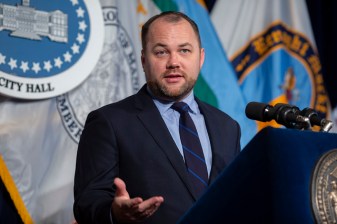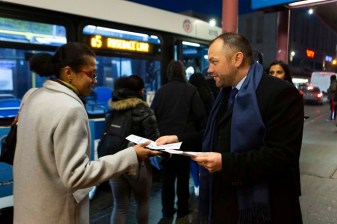Corey Johnson for Mayor: Will He ‘Break’ or Merely ‘Bend’ the Car Culture?

Council Speaker Corey Johnson has energized livable streets advocates with his legislative agenda towards more bike lanes, busways and pedestrian zones — and his constant repetition of the heartbeat-raising promise to “break the car culture.” But in a keynote address at last week’s Vision Zero Cities conference, Streetsblog detected a tiny note of compromise in the language of the one-time “hero” award winner and would-be mayor. Mario Cuomo used to say that politicians “campaign in poetry, but govern in prose” — but Johnson’s latest comments were definitely not iambic pentameter. He spoke to our editor, Gersh Kuntzman, after his well-received speech.
Gersh Kuntzman: I just heard your speech and I think I’m now seeing how you’re going to translate “break the car culture” into a mayoral platform. You’re saying you know you’re not going to get rid of cars across the entire city, especially in parts of Brooklyn and Queens where people don’t want to give up their cars. But I think I also heard in your speech a new notion: “You want your car? Keep it. But if I’m mayor, I’ll make it less likely that you’ll want, or even need, to use it.” Did I hear you right?
Corey Johnson: It just makes sense. We know realistically without significant subway expansion for transit deserts in New York City — and for the 25 percent, or whatever the number is, of New Yorkers who use their cars on a daily or weekly or basis to commuter — you need to give them other options [fact check: It is roughly 25 percent]. I have friends who own a car and they say to me all the time, “I use it more lately because the subways and buses aren’t great” even though it’s gotten better over the last year and a half.
GK: Wait, friends of yours in Manhattan drive around … Manhattan?!

CJ: People in Manhattan and Brooklyn, too. The whole point is to say you need to do a bunch of things. Number 1, for a second — not because it’s not important, but put safety aside. Put climate change aside. Put traffic violence aside. Put all the things that are important in this equation aside and talk about something fundamental: let’s make it not a nightmare to get around. And for most New Yorkers, it’s hard to live in New York City. They feel like their quality of life is not great. Rents are getting more expensive. The cost of the subway has gone up. It’s hard. So let’s make it easier to get around. If you invest in mass transit, make it easier to walk and bike and take the bus, you’re improving the quality of life of many New Yorkers who will say, “Now that the subway is working and now that the bus is sped up and now that it’s safer to cycle because there’s a protected bike lane network, I’m going to actually abandon my car — use it less or abandon it entirely, and use these other methods.” A lot of places right now in New York City have transportation infrastructure, but not built in the right way for [residents], safe and reliable. That is the context we need to use here.
GK: Come on, but will people who really use their car all the time buy into that pitch or will they say, “Here’s another effete Manhattan intellectual handing me another war on cars like de Blasio”?
CJ: There are some people who feel very attached to their cars. It’s a neighborhood-by-neighborhood thing. If you actually improve the subway service enough and the bus service enough in those neighborhoods that actually have subway stops and express bus stops and dedicated bus lanes, then in those neighborhoods, people would say, “It’s actually working.” But it’s hard to even have that conversation when people feel like for the last five years there’s been such a decline — except for the last year under Andy Byford — in the reliability of mass transit. If you increase reliability, you can have that broader conversation. There are other parts of the city, though — and it’s important to acknowledge this — that even if you put additional bus service or bike lanes or even if you pedestrianize it, there’s still going to be heavy car-dependent neighborhoods because you don’t have subway access, such as in Eastern Queens or parts of south Brooklyn or parts of the north Bronx or Staten Island. In those neighborhoods, it’s about changing the infrastructure on the streets so that it’s safe to bike and walk around if you are doing that there. You still are going to have a heavy car culture in those neighborhoods, but this is about changing the quality of life for New Yorkers and making it easier for them to get around.




